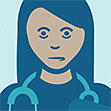November 4th, 2016
From the Prescription Pad to Reality
April Edwards, MD

April Edwards, MD, is the 2016-17 Chief Resident for Internal Medicine/Pediatrics program at the University of North Carolina School of Medicine.
A harsh reality I am coming to terms with, as a newly minted “pre-tending,” is that we don’t know the cost of the care we provide. There are recommendations for things like High Value Care, from organizations like the ACP. But how much do things actually cost? Certain apps and websites, like the Healthcare Bluebook, give you an idea of the cost of tests, procedures, and medications that you are ordering for your patients. But often, especially at hospitals like mine, public hospitals that serve many uninsured, under-insured, and Medicare/Medicaid patients, we encounter situations where patients can’t afford the services and medications that they need. I often find myself turning to sites like Good Rx to get coupons for patients, but, beyond this, the reality is that I don’t know where they can get affordable care.
I live in North Carolina, and I recently had a patient with presumed Rickettsial illness who was unable to afford doxycycline. I assumed this antibiotic was so basic and simple and been marketed for such a long time that surely it had to be accessible. But he wasn’t able to afford it. So how can we help? What tools are at our disposal?
Good Rx is one. If you type in a drug name, it will show you the pharmacies near the patient’s home that have that medication; the patient can compare prices at different pharmacies in the area. You can get printable coupons; you can print a voucher for the medication. We use the old standbys of the WalMart $4 list and the Target $4 list, and many medications are on those. Other resources exist, like Formulary Search, to tell you what is preapproved by a patient’s insurance. Remember all that prior auth paperwork? There are budding apps to help you with that.
But this is one of the things that we just don’t receive any training on during medical school and residency. I wish that it doesn’t matter — that “I’ll just prescribe the Best Therapy for my patient.” But I’m realizing that is a real struggle. In real life, if the benefit of the Best Therapy is something like 0.05%, but that Best Therapy is 10 times more expensive than the next best drug, sometimes it makes sense to recommend the one that is technically inferior but affordable. Because my patient will then actually be getting treatment.
It’s hard when your best intentions are met with a roll of red tape. It’s a real issue for all of our graduates fresh from residency. We are still shiny and hopeful. We haven’t become so jaded that we don’t want to Do Good. But we could use the tools to help us accomplish that.
Post your favorite resources that help you Do Good! Help others to stop grasping in the darkness!
Residency isn’t easy. But it doesn’t have to be quite so hard. Explore NEJM Resident 360 now.




How about for Canadians?
I’ve created a guide for our med students. While some of the sources are restricted (e.g. UpToDate) most are open source. Good idea to look for sources of affordable drugs versus pricing on drugs.
It seems like EMRs should be able to help with this. Just hover over the name of a potential order, and it gives you the estimated cash price.
This is an important issue. As a home care nurse for people with psychiatric and substance abuse involvement, I see this all the time, and my options are limited. I find myself paying out of my own pocket for prescriptions my patients need to remain stable, but I can’t continue to do that as I now have to think about my own family. I’m taking food out of the mouths of my babies to do that. My other option is to “waive” the co-pay at the pharmacy, which these patients had been doing long before I entered their lives, but that’s only a temporary fix. I have patients who owe thousands of dollars to their pharmacy. And so you can see the issue with that on a larger scale. Thousands of dollars that they can never re-pay, so now the pharmacy carries their burden…
Very accurate posting.